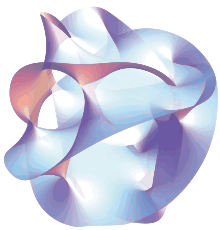A teoria das cordas Twistor é uma teoria para unir twistor e teoria das cordas proposta por Edward Witten, em 2003, incorporando o modelo topológico B[1] da teoria das cordas no espaço twistor.[2] A teoria é uma equivalência entre N = 4 teoria de supersimétrica de Yang-Mills[3] e a teoria perturbativa topológica das cordas do modelo B[4] no espaço twistor.[5]
- ↑ Ita, Harald; Nieder, Harald; Oz, Yaron; Sakai, Tadakatsu (25 de maio de 2004). «Topological B-Model, Matrix Models, $\hat{c}=1$ Strings and Quiver Gauge Theories». Journal of High Energy Physics (05): 058–058. ISSN 1029-8479. doi:10.1088/1126-6708/2004/05/058. Consultado em 1 de abril de 2022
- ↑ «Twistor theory». www.scientificlib.com (em inglês). Consultado em 1 de abril de 2022
- ↑ Dijkgraaf, Robbert; Park, Jae-Suk; Schroers, Bernd (23 de fevereiro de 1999). «N=4 Supersymmetric Yang-Mills Theory on a Kaehler Surface». arXiv:hep-th/9801066. Consultado em 1 de abril de 2022
- ↑ Klemm, Albrecht (2018). Clader, Emily; Ruan, Yongbin, eds. «The B-Model Approach to Topological String Theory on Calabi-Yau n-Folds». Cham: Springer International Publishing (em inglês): 79–397. ISBN 978-3-319-94220-9. doi:10.1007/978-3-319-94220-9_2. Consultado em 1 de abril de 2022
- ↑ Witten, Edward (dezembro de 2004). «Perturbative Gauge Theory As A String Theory In Twistor Space». Communications in Mathematical Physics (1-3): 189–258. ISSN 0010-3616. doi:10.1007/s00220-004-1187-3. Consultado em 1 de abril de 2022

